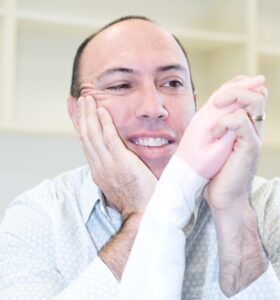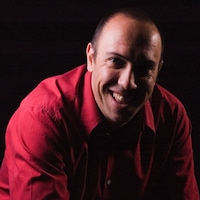I am thrilled that Dr David Butler; he of the custard tart; the Duke of Irreverence; the internationally acclaimed clinical revolutionary, has started a blog. I am chuffed that he showed me his first post before it went live. And I could not help but respond because it takes two to tango and I have a few thoughts on this issue myself.
I have both ‘clinical’ and ‘scientist’ in my job title. This is not an accident. This is a reflection of the shared intent that my University, the University of South Australia, and I, have to foster engagement between the two. In reality, like most people in my role, I am nearly all research – I see about 4 patients a week for clinical consults. My research group is now nudging 30 people and 22 of them are qualified clinicians, several with extensive experience and a top-shelf reputation. I am not half the clinician they are, or David is, or that most of you reading this are, but my research is always driven by clinical problems.
So Dave senses an unhealthy straining of relationships between clinicians and scientists in rehabilitation. I have an alternative view – I agree about the straining but I don’t think it is unhealthy – it feels more like the straining that goes on between siblings while they find their own place in the world and work out how to be different but compatible, or between a tightly committed couple who are having to negotiate their way through unfamiliar tensions. There is no doubt that the context in which science and clinical practice are driven places a huge strain on both scientists and clinicians and, clearly, on the relationship between them. As Dave points out – there is value here in understanding the strains on both sides. I will speak for the scientist first, in response to David’s Lament of The Angry Clinician.
The key performance indicators for a scientist are (i) Impact, (ii) Service to the field, and (iii) Service to science. Impact is conventionally measured by articles and, moreso, how many times those articles are cited by other articles; and grant income (although this is daft as a measure of impact and rewards inefficient research teams – the UK either has, or is considering, a metric based on cost per article, which makes a $1million randomized controlled trial (this is about the going rate), for a return of 3 – 4 papers, a pretty poor option). The Australian medical research council (NHMRC) is blowing a trumpet about diversifying what is considered to be impact. For example, policy reports, clinical guideline documents, web and social media presence are all on the record, but I am yet to see them taken seriously by peer review panels. I expect they will in time, but not just yet. Service to the field is conference talks, committees, clinical review panels, engagement with clinical and consumer groups, community service (eg public lectures) and giving professional development courses. Service to science is editorial boards, conference committees, peer review of other people’s articles, grant review panels etc.
Put yourself then, in the shoes of a scientist. Remember that a scientific path is all about discovery, innovation and rigour – it is about truth and possibility. One might say that people don’t choose to be a scientist, science chooses them. Now imagine that your chance of getting support to do your science is about 20%. Your chance of getting a salary to concentrate solely on your science is about 8%. And you know that unless you show in the next 5 years that you have made an impact, served the field and served science, with documented evidence (you can’t talk your way into this club), you are out. These are immense pressures – pressures that will lead researchers to maximise impact, for example strategically presenting their findings. Indeed, ‘clinicians see scientific arrogance emerge, of proclamations of what to do in the clinic by clinically immature researchers’. I don’t think that giving clinical advice is necessarily a bad thing – the biomechanist who tested the motorbike helmet would seem well placed to tell you which one to wear. But spinning an article in order to give clinical advice is, to me, a clear piece of impact boosting. But are clinicians always disappointed by this? How many times have you complained about scientists saying ‘more research is needed’. I reckon the disappointment in a scientist’s clinical recommendations would relate pretty well with how strongly you disagree with them.
But are clinicians any different to scientists on the impact issue? Impact is again the key performance indicator. A great clinician has great impact – both on the patient in front of them, but also on their own audience, at a conference or professional development course. I think we both face the challenge of seeking impact but remaining precise and honest. Being precise as a scientist means we simply must accept the limitations of what we have discovered – speculation and extrapolation MUST be labeled as such (this is the lament of the University media department – ‘but can’t we say we give hope to the millions of diabetics out there?’…etc etc). Being precise as a scientist means less spin, which means less impact, and we need to take that on the chin.
Being precise as a clinician means the same thing – the clinical guru has, in my view, no less responsibility than the clinically naïve scientist. Perhaps the clinically naïve scientist should be careful when telling people how to treat, but the scientifically naïve clinician should not take the ‘this works – trust me I am a guru’ line. Last year I heard such a ‘guru’, author of many books, state ‘if your patients are not responding, then you need to come to one of my courses – my latest book is included in the fee’ and then proceeded to put a list that had him teaching clinicians how to treat nearly every day of the year. In my view we both have conflicts of interest – impact versus precision and honesty – that are very difficult to keep in check.
In final defence of the scientists – scientific training puts precision and honesty at its core. Precision and honesty are goals in themselves. We are accountable to one another. That we are doing this on a ridiculously competitive playing field reinforces the need for these core values and the need for accountability of process. Are clinicians similarly bound with regards to process? I suggest not, what matters most in the clinic is whether patients get better, not necessarily how they do.
I like Dave’s suggestions for scientists (although beware – to get a name on a paper requires a huge time and energy commitment), but would like to add, and finish, with this advice to scientists AND clinicians alike:
Do not compromise precision or honesty in the pursuit of impact.
About Lorimer Moseley
 Lorimer is NHMRC Senior Research Fellow with twenty years clinical experience working with people in pain. After spending some time as a Nuffield Medical Research Fellow at Oxford University he returned to Australia in 2009 to take up an NHMRC Senior Research Fellowship at Neuroscience Research Australia (NeuRA). In 2011, he was appointed Professor of Clinical Neurosciences & the Inaugural Chair in Physiotherapy at the University of South Australia, Adelaide. He runs the Body in Mind research groups. He is the only Clinical Scientist to have knocked over a water tank tower in Outback Australia.
Lorimer is NHMRC Senior Research Fellow with twenty years clinical experience working with people in pain. After spending some time as a Nuffield Medical Research Fellow at Oxford University he returned to Australia in 2009 to take up an NHMRC Senior Research Fellowship at Neuroscience Research Australia (NeuRA). In 2011, he was appointed Professor of Clinical Neurosciences & the Inaugural Chair in Physiotherapy at the University of South Australia, Adelaide. He runs the Body in Mind research groups. He is the only Clinical Scientist to have knocked over a water tank tower in Outback Australia.
Link to Lorimer’s published research here. Downloadable PDFs here.



